7 Key Advantages of Pad Mount Transformers in Modern Electrical Systems
Have you ever wondered why those green boxes are popping up in your neighborhood? They’re not just for decoration – they’re changing the game in electrical distribution.
Pad mount transformers offer significant advantages in modern electrical systems, including enhanced safety, space efficiency, aesthetic appeal, improved reliability, easy maintenance, environmental protection, and cost-effectiveness. These benefits make them ideal for urban and suburban power distribution needs.
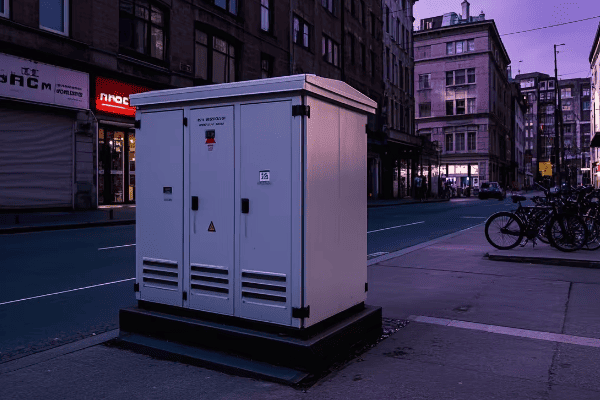
As someone who’s been in the electrical industry for years, I’ve seen firsthand how pad mount transformers are revolutionizing our power systems. Let’s dive into the key advantages that make these transformers a game-changer in modern electrical infrastructure.
What Are Pad Mount Transformers? A Quick Introduction
Ever noticed those green metal boxes in your neighborhood? They’re not just random utility equipment – they’re the unsung heroes of our modern power grid.
Pad mount transformers are ground-level electrical distribution transformers enclosed in a locked steel cabinet. They convert high-voltage electricity from power lines to lower voltages suitable for homes and businesses, offering a safer and more aesthetically pleasing alternative to traditional pole-mounted transformers.
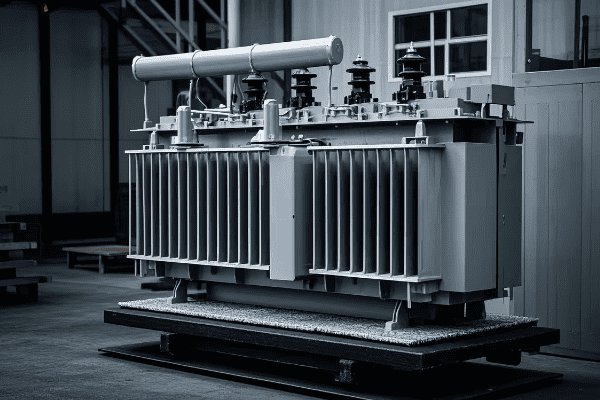
Let’s break down the key components and features of pad mount transformers:
Core Components
-
Transformer Core and Windings
- Heart of the transformer
- Converts voltage levels
-
Insulating Oil
- Cools and insulates internal components
- Improves efficiency and longevity
-
Steel Cabinet
- Protects internal components
- Provides safety barrier
-
High and Low Voltage Bushings
- Connect transformer to power lines and distribution cables
Key Features
-
Ground-Level Installation
- Easy access for maintenance
- No need for poles or overhead lines
-
Compact Design
- Fits in smaller spaces
- Ideal for urban and suburban areas
-
Tamper-Resistant Enclosure
- Locked cabinet prevents unauthorized access
- Enhances public safety
-
Customizable Appearance
- Can be painted or designed to blend with surroundings
- Minimizes visual impact
I remember my first encounter with a pad mount transformer during a residential development project. I was amazed at how such a powerful piece of equipment could be so discreetly integrated into the landscape. It was a far cry from the bulky pole-mounted transformers I was used to seeing.
Here’s a quick comparison table between pad mount and traditional pole mount transformers:
| Feature | Pad Mount | Pole Mount |
|---|---|---|
| Installation | Ground level | Elevated on poles |
| Accessibility | Easy | Requires climbing or lift |
| Visual Impact | Low | High |
| Safety | High (enclosed) | Moderate (exposed) |
| Space Efficiency | High | Low |
| Customization | Flexible | Limited |
| Maintenance | Simpler | More complex |
Pad mount transformers are not just about looks, though. Their design offers numerous practical advantages that we’ll explore in detail. From enhanced safety to improved reliability, these transformers are changing the way we think about power distribution in modern settings.
Enhanced Safety: How Pad Mount Transformers Reduce Electrical Hazards
Safety is paramount in electrical systems. But have you ever worried about the exposed transformers on poles in your neighborhood? Pad mount transformers offer a solution that puts those concerns to rest.
Pad mount transformers significantly reduce electrical hazards through their enclosed design, tamper-resistant features, and ground-level installation. This configuration minimizes the risk of accidental contact, vandalism, and weather-related incidents, making them a safer option for urban and residential areas.
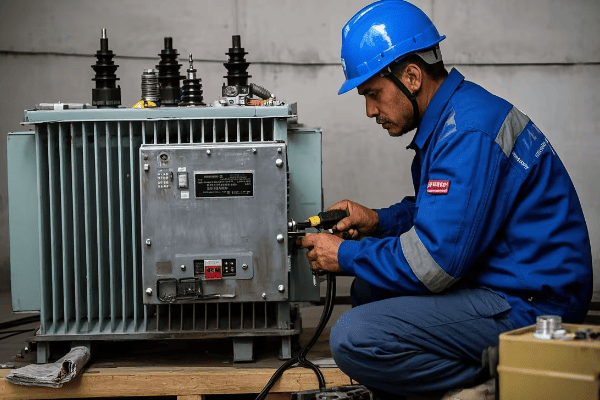
Let’s dive deeper into the safety features that make pad mount transformers stand out:
1. Enclosed Design
The most obvious safety feature of pad mount transformers is their fully enclosed cabinet. This design offers multiple safety benefits:
- Protection from Elements: The cabinet shields the transformer from rain, snow, and debris, reducing the risk of weather-related malfunctions.
- Animal Protection: It prevents animals from coming into contact with live components, which is a common issue with pole-mounted transformers.
- Vandalism Deterrent: The solid enclosure makes it difficult for vandals to access or damage critical components.
2. Tamper-Resistant Features
Pad mount transformers are designed with security in mind:
- Locked Access: The cabinet is equipped with locks that only authorized personnel can open.
- Warning Labels: Clear warning signs deter unauthorized access attempts.
- Concealed Connections: High-voltage connections are hidden from view, reducing temptation for tampering.
3. Ground-Level Installation
Installing transformers at ground level offers several safety advantages:
- No Climbing Required: Maintenance can be performed without the need for bucket trucks or climbing, reducing worker risk.
- Stability: Ground-level installation means less risk of falling during storms or accidents.
- Quick Access in Emergencies: First responders can easily access the transformer if needed.
4. Improved Grounding
Pad mount transformers often have superior grounding systems:
- Direct Earth Connection: The pad provides an excellent grounding surface.
- Multiple Grounding Points: This ensures better protection against electrical faults.
5. Arc Flash Protection
Modern pad mount transformers incorporate advanced arc flash protection:
- Containment: The enclosed design helps contain potential arc flashes.
- Pressure Relief: Many models include pressure relief devices to safely vent in case of an internal fault.
Here’s a comparison of safety features between pad mount and pole mount transformers:
| Safety Feature | Pad Mount | Pole Mount |
|---|---|---|
| Enclosed Design | Yes | No |
| Tamper Resistance | High | Low |
| Ground-Level Access | Yes | No |
| Weather Protection | High | Low |
| Animal Contact Prevention | High | Low |
| Arc Flash Containment | Yes | Limited |
| Grounding Efficiency | High | Moderate |
| Public Exposure Risk | Low | High |
I recall a project where we replaced old pole-mounted transformers with pad mount units in a residential area prone to storms. The following year, during a severe thunderstorm, while many pole-mounted transformers in neighboring areas failed, our pad mount transformers remained operational and safe. This not only prevented power outages but also eliminated the safety risks associated with downed power lines.
The enhanced safety of pad mount transformers extends beyond just the equipment itself. It also improves the overall safety of the surrounding area:
- Reduced Climbing Hazards: Eliminates the temptation for children to climb poles.
- Clearer Sightlines: No poles means better visibility for drivers and pedestrians.
- Fewer Overhead Lines: Reduces risks associated with fallen power lines during storms.
In urban planning, the safety benefits of pad mount transformers are becoming increasingly recognized. Many cities now prefer or even mandate their use in new developments, especially in residential areas and near schools or parks.
While no electrical equipment is 100% risk-free, pad mount transformers represent a significant step forward in electrical safety. Their design addresses many of the vulnerabilities associated with traditional pole-mounted transformers, making them an excellent choice for modern, safety-conscious electrical systems.
Space Efficiency: Maximizing Land Use with Compact Pad Mount Designs
In today’s urban landscapes, every square foot counts. Have you ever wondered how we can power our growing cities without cluttering our streets with bulky electrical equipment? The answer lies in the compact design of pad mount transformers.
Pad mount transformers maximize land use efficiency through their compact, ground-level design. They eliminate the need for large overhead structures and can be easily integrated into landscaping or existing structures. This space-saving feature is crucial in dense urban areas and modern residential developments.
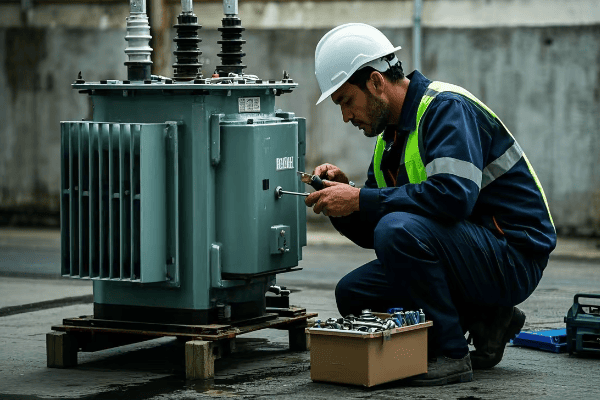
Let’s explore how pad mount transformers contribute to space efficiency:
1. Compact Footprint
Pad mount transformers are designed to be as compact as possible:
- Smaller Ground Area: They typically require less than 10 square feet of ground space.
- Vertical Space Savings: By eliminating the need for poles, they free up valuable airspace.
- Flexible Placement: Can be installed close to buildings or property lines.
2. Underground Connections
One of the key space-saving features is the use of underground connections:
- No Overhead Lines: Eliminates the need for unsightly and space-consuming overhead wires.
- Reduced Clearance Requirements: Without overhead lines, there’s no need for large clearance areas around the transformer.
- Streamlined Appearance: Creates a cleaner, more organized look in urban and suburban areas.
3. Integration with Surroundings
Pad mount transformers can be creatively integrated into their environment:
- Landscaping: Can be surrounded by shrubs or incorporated into garden designs.
- Structural Integration: Some designs allow for integration into walls or building foundations.
- Multi-Use Spaces: The area above and around the transformer can often be utilized for other purposes.
4. Scalability
The compact design of pad mount transformers allows for easy scaling of electrical infrastructure:
- Modular Installation: Multiple units can be installed side by side for higher capacity needs.
- Easy Upgrades: Replacing or upgrading units is simpler and less disruptive than with pole-mounted systems.
Here’s a comparison of space utilization between pad mount and pole mount transformers:
| Aspect | Pad Mount | Pole Mount |
|---|---|---|
| Ground Footprint | Small (< 10 sq ft) | Larger (pole base + clearance) |
| Vertical Space Use | Minimal | Significant |
| Overhead Line Requirement | None | Extensive |
| Landscaping Compatibility | High | Low |
| Urban Integration | Easy | Challenging |
| Scalability | High | Limited |
| Multi-Use Space Potential | Yes | No |
I once worked on a project to revitalize a dense urban neighborhood. The city wanted to increase power capacity without sacrificing valuable real estate. By switching to pad mount transformers, we were able to triple the electrical capacity while actually reducing the visible footprint of the electrical infrastructure. This freed up space for wider sidewalks and small pocket parks, greatly enhancing the neighborhood’s livability.
The space efficiency of pad mount transformers offers several additional benefits:
- Improved Property Values: By freeing up space and improving aesthetics, they can positively impact property values.
- Enhanced Urban Planning: Allows for more flexible and creative urban design solutions.
- Reduced Right-of-Way Requirements: Simplifies the process of obtaining permissions for new installations.
In modern urban development, the space-saving qualities of pad mount transformers are becoming increasingly valuable. As cities grow denser and land becomes more precious, the ability to provide robust electrical infrastructure without consuming large amounts of space is crucial.
Pad mount transformers represent a smart solution for balancing the growing power needs of urban areas with the desire for open, uncluttered spaces. Their compact design not only saves space but also opens up new possibilities for urban planning and development.
Aesthetic Appeal: Integrating Pad Mount Transformers into Urban Landscapes
Have you ever noticed how some neighborhoods seem cleaner and more visually appealing than others? The secret might lie in how they handle their electrical infrastructure, particularly with the use of pad mount transformers.
Pad mount transformers offer significant aesthetic advantages over traditional pole-mounted units. Their low profile and customizable enclosures allow for seamless integration into urban and suburban landscapes. This aesthetic flexibility helps maintain the visual appeal of neighborhoods while providing essential electrical infrastructure.

Let’s explore how pad mount transformers contribute to the aesthetic appeal of urban environments:
1. Low Visual Profile
One of the most immediate aesthetic benefits of pad mount transformers is their low visual profile:
- Height Reduction: Typically standing only 4-5 feet tall, much lower than pole-mounted alternatives.
- Reduced Skyline Clutter: Eliminates the need for overhead wires and poles that can obstruct views.
- Ground-Level Integration: Can be easily incorporated into ground-level landscaping designs.
2. Customizable Appearance
Pad mount transformers offer a high degree of customization to match their surroundings:
- Color Options: Enclosures can be painted to blend with the environment or match architectural styles.
- Textured Finishes: Available in various textures to complement different settings (e.g., brick, stone, or wood grain).
- Artistic Designs: Some communities use transformer enclosures as canvases for public art or murals.
3. Landscaping Integration
The design of pad mount transformers allows for creative landscaping solutions:
- Shrub Screening: Can be surrounded by appropriate vegetation for natural concealment.
- Hardscape Elements: Incorporation into retaining walls, fences, or other structural elements.
- Garden Features: Some designs allow transformers to double as planters or garden structures.
4. Architectural Harmony
Pad mount transformers can be designed to complement local architecture:
- Style Matching: Enclosures can mimic architectural features of surrounding buildings.
- Historical Preservation: In historic districts, designs can be tailored to maintain period aesthetics.
- Modern Integration: Sleek designs can enhance contemporary urban landscapes.
Here’s a comparison of aesthetic features between pad mount and pole mount transformers:
| Aesthetic Aspect | Pad Mount | Pole Mount |
|---|---|---|
| Visual Impact | Low | High |
| Customization Options | Extensive | Limited |
| Landscaping Compatibility | High | Low |
| Architectural Integration | Easy | Difficult |
| Skyline Impact | Minimal | Significant |
| Potential for Artistic Use | High | Low |
| Historical Area Suitability | Adaptable | Often Incompatible |
I remember a project in a historic downtown area where the local preservation society was initially against any new electrical infrastructure. We proposed pad mount transformers designed to look like vintage street furniture, complete with period-appropriate paint and detailing. Not only did this solution meet the area’s power needs, but it also enhanced the historic charm of the neighborhood. The transformers became talking points for tourists, blending utility with historical aesthetics.
The aesthetic benefits of pad mount transformers extend beyond just looks:
- Increased Property Values: Improved aesthetics can positively impact real estate values in the area.
- Community Pride: Well-designed infrastructure can contribute to a sense of community pride and care.
- Tourism Potential: In some cases, creatively designed transformers can become minor local attractions.
In urban planning and development, the aesthetic appeal of electrical infrastructure is becoming increasingly important. As cities strive to create more livable, attractive spaces, the ability to provide essential services without visual disruption is crucial.
Pad mount transformers represent a perfect blend of function and form in modern urban design. They prove that necessary infrastructure doesn’t have to be an eyesore. Instead, with thoughtful design and integration, these transformers can actually enhance the visual appeal of our urban and suburban landscapes.
By choosing pad mount transformers, communities can maintain their aesthetic integrity while still meeting growing power needs. It’s a win-win solution that keeps our cities both beautiful and powered for the future.
Improved Reliability: Weather Resistance of Pad Mount Transformers
Have you ever experienced a power outage during a storm and wondered why? The answer often lies in how well our electrical equipment can withstand the elements. This is where pad mount transformers shine.
Pad mount transformers offer improved reliability through enhanced weather resistance. Their sealed, ground-level design protects critical components from rain, snow, ice, and wind. This results in fewer weather-related outages and longer operational life compared to traditional pole-mounted transformers.

Let’s explore how pad mount transformers stand up to various weather conditions:
1. Protection Against Rain and Flooding
Pad mount transformers are designed with water resistance in mind:
- Sealed Enclosures: Prevent water ingress during heavy rains.
- Elevated Pads: Often installed on slightly raised concrete pads to avoid ground-level flooding.
- Water-Resistant Seals: High-quality seals around doors and cable entries keep moisture out.
2. Snow and Ice Resistance
In colder climates, pad mount transformers have several advantages:
- Reduced Ice Buildup: The lack of overhead components means less surface area for ice accumulation.
- Heat Generation: Internal heat helps prevent snow and ice buildup around the unit.
- Easy Snow Removal: Ground-level installation allows for easier clearing of snow around the transformer.
3. Wind Resistance
High winds pose less of a threat to pad mount transformers:
- Low Profile: Presents less surface area to wind, reducing the risk of damage.
- Sturdy Construction: Heavy-duty enclosures are designed to withstand high wind speeds.
- No Overhead Lines: Eliminates the risk of wind-related line damage common with pole-mounted transformers.
4. Lightning Protection
While no electrical equipment is completely immune to lightning, pad mount transformers offer some advantages:
- Grounding Systems: Often have more comprehensive grounding than pole-mounted units.
- Surge Arresters: Equipped with devices to divert lightning-induced surges.
- Enclosed Design: Provides an additional layer of protection for internal components.
5. Temperature Extremes
Pad mount transformers are designed to operate in a wide range of temperatures:
- Insulated Cabinets: Help maintain stable internal temperatures in both hot and cold climates.
- Cooling Systems: Many models include advanced cooling systems for high-temperature environments.
- Cold Weather Operation: Less exposed to extreme cold compared to pole-mounted units.
Here’s a comparison of weather resistance features between pad mount and pole mount transformers:
| Weather Factor | Pad Mount | Pole Mount |
|---|---|---|
| Rain Protection | Excellent | Moderate |
| Flood Resistance | Good (if elevated) | Better (naturally elevated) |
| Snow/Ice Buildup | Minimal | Significant |
| Wind Resistance | High | Moderate |
| Lightning Protection | Good | Moderate |
| Extreme Temperature Performance | Better | Variable |
| Overall Weather-Related Reliability | Higher | Lower |
I recall a project in a coastal area prone to hurricanes. We replaced the old pole-mounted transformers with pad mount units. The following year, when a Category 3 hurricane hit, the pad mount transformers remained operational throughout the storm, while many pole-mounted units in neighboring areas failed. This not only kept the lights on for residents but also significantly reduced post-storm recovery time and costs.
The improved weather resistance of pad mount transformers offers several additional benefits:
- Reduced Maintenance Costs: Less weather-related damage means lower long-term maintenance expenses.
- Improved Power Quality: Fewer weather-induced fluctuations lead to more stable power supply.
- Longer Lifespan: Protection from the elements contributes to an extended operational life.
In areas with challenging weather conditions, the reliability of pad mount transformers becomes even more crucial. They play a vital role in ensuring consistent power supply during extreme weather events, which is increasingly important in our climate-changing world.
For utility companies and city planners, the weather resistance of pad mount transformers translates to:
- Fewer Customer Complaints: Reduced outages lead to higher customer satisfaction.
- Lower Emergency Response Costs: Fewer weather-related failures mean less need for emergency repairs.
- Improved Grid Resilience: A more weather-resistant infrastructure enhances overall grid stability.
In conclusion, the superior weather resistance of pad mount transformers is not just about keeping the lights on during a storm. It’s about building a more resilient, reliable electrical infrastructure that can withstand the challenges of our changing climate while providing consistent service to communities.
Easy Maintenance: Accessibility Features of Pad Mount Transformers
Have you ever wondered why some power outages seem to last longer than others? Often, it comes down to how easily technicians can access and maintain the electrical equipment. This is where pad mount transformers really shine.
Pad mount transformers offer superior accessibility for maintenance compared to traditional pole-mounted units. Their ground-level installation allows for easier inspection, servicing, and repair. This accessibility not only reduces maintenance time and costs but also improves overall system reliability through more frequent and thorough checks.

Let’s explore the key accessibility features that make pad mount transformers a maintenance-friendly option:
1. Ground-Level Access
The most obvious advantage of pad mount transformers is their ground-level installation:
- No Climbing Required: Eliminates the need for bucket trucks or climbing gear.
- Safer Working Conditions: Reduces the risk of falls and other height-related accidents.
- All-Weather Access: Easier to perform maintenance in various weather conditions.
2. Hinged Cabinet Doors
Most pad mount transformers feature well-designed access points:
- Wide-Opening Doors: Allow technicians to easily reach all components.
- Secure Locking Mechanisms: Provide quick access for authorized personnel while ensuring security.
- Weather-Resistant Seals: Maintain the integrity of the enclosure when closed.
3. Modular Design
Many modern pad mount transformers are built with a modular approach:
- Replaceable Components: Allow for quick swapping of faulty parts.
- Standardized Layouts: Consistent designs across models for easier familiarization and maintenance.
- Upgradeable Systems: Easier to upgrade or add new features without replacing the entire unit.
4. Built-in Diagnostic Features
Advanced pad mount transformers often include diagnostic capabilities:
- Monitoring Systems: Built-in sensors for real-time performance tracking.
- Visible Gauges: Easy-to-read indicators for oil levels, temperature, and pressure.
- Test Points: Accessible points for connecting diagnostic equipment.
5. Spacious Work Area
The design of pad mount transformers often includes considerations for maintenance work:
- Ample Internal Space: Room for technicians to work comfortably inside the cabinet.
- External Working Surface: Some models include a fold-down platform for tools and equipment.
- Good Lighting: Either through transparent panels or built-in lighting systems.
Here’s a comparison of maintenance accessibility between pad mount and pole mount transformers:
| Accessibility Feature | Pad Mount | Pole Mount |
|---|---|---|
| Ground-Level Access | Yes | No |
| Need for Specialized Equipment | Minimal | Extensive (bucket trucks, etc.) |
| Ease of Component Replacement | High | Moderate to Low |
| Safety During Maintenance | High | Moderate (height risks) |
| All-Weather Maintenance Capability | High | Limited |
| Diagnostic Feature Accessibility | Easy | Often Challenging |
| Space for Maintenance Work | Ample | Limited |
I remember a project where we upgraded an industrial park from pole-mounted to pad mount transformers. The maintenance team was initially skeptical about the change. However, after just a few months, they reported a 40% reduction in maintenance time and a significant improvement in their ability to perform thorough inspections. This not only saved costs but also allowed them to catch and prevent several potential issues before they became major problems.
The easy maintenance of pad mount transformers brings several additional benefits:
- Reduced Downtime: Quicker maintenance means shorter outages during repairs.
- Improved Preventive Maintenance: Easier access encourages more regular check-ups.
- Lower Labor Costs: Less time and fewer personnel required for routine maintenance.
- Enhanced Safety: Reduced risk of accidents during maintenance procedures.
For utility companies and facility managers, the accessibility of pad mount transformers translates to:
- More Efficient Resource Allocation: Maintenance teams can service more units in less time.
- Improved Asset Longevity: Regular, thorough maintenance extends the life of the equipment.
- Better Emergency Response: Faster access and repairs during critical situations.
In the broader context of electrical infrastructure management, the easy maintenance of pad mount transformers contributes to:
- Higher System Reliability: Regular maintenance leads to fewer unexpected failures.
- Increased Customer Satisfaction: Fewer and shorter outages improve service quality.
- Cost-Effective Operations: Lower long-term maintenance costs benefit both providers and consumers.
In conclusion, the accessibility features of pad mount transformers represent a significant advancement in electrical infrastructure maintenance. By making it easier, safer, and more efficient to maintain these critical components, pad mount transformers help ensure a more reliable and resilient power distribution system for our communities.
Environmental Protection: Minimizing Ecological Impact with Pad Mount Systems
In today’s world, environmental concerns are at the forefront of many industries. But have you ever considered the ecological impact of the transformers that power our homes and businesses? Pad mount transformers offer a greener alternative that’s worth exploring.
Pad mount transformers contribute to environmental protection by minimizing land use, reducing the risk of oil spills, and decreasing the impact on wildlife. Their compact, sealed design and integration with underground systems result in less habitat disruption and lower electromagnetic field emissions compared to traditional pole-mounted transformers.
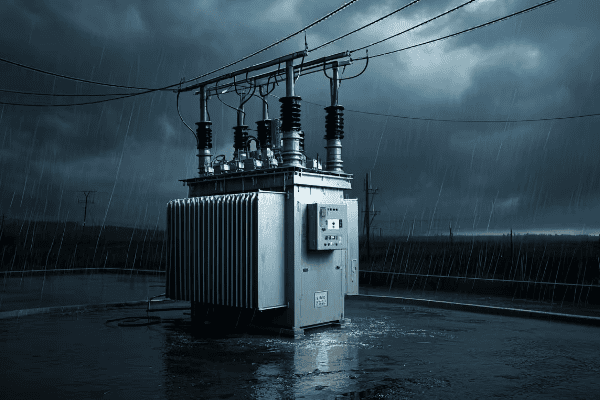
Let’s delve into the environmental benefits of pad mount transformers:
1. Reduced Land Use
Pad mount transformers have a smaller ecological footprint:
- Compact Design: Requires less cleared land than pole-mounted systems.
- Underground Cabling: Eliminates the need for overhead lines, preserving trees and natural landscapes.
- Integration with Existing Structures: Can be incorporated into buildings or urban landscapes, minimizing additional land use.
2. Minimized Oil Spill Risk
Modern pad mount transformers are designed with environmental safety in mind:
- Sealed Containment: Robust enclosures significantly reduce the risk of oil leaks.
- Secondary Containment: Many models include built-in oil catchment systems.
- Leak Detection Systems: Advanced units feature early warning systems for potential leaks.
3. Wildlife Protection
The design of pad mount transformers helps protect local wildlife:
- No Overhead Lines: Reduces risks to birds and other animals that might collide with or be electrocuted by overhead wires.
- Enclosed Design: Prevents animals from accessing dangerous components.
- Reduced Habitat Disruption: Smaller footprint means less impact on natural habitats.
4. Lower Electromagnetic Field (EMF) Emissions
Pad mount transformers often have lower EMF emissions:
- Shielded Design: Metal enclosures provide natural EMF shielding.
- Ground-Level Placement: EMF strength decreases rapidly with distance, so ground-level placement reduces human exposure.
- Advanced Designs: Some models incorporate additional EMF reduction technologies.
5. Energy Efficiency
Many pad mount transformers are designed for improved energy efficiency:
- Advanced Materials: Use of high-efficiency core materials reduces energy losses.
- Better Cooling Systems: More efficient cooling leads to lower energy waste.
- Smart Grid Compatibility: Easier integration with smart grid systems for optimized power distribution.
Here’s a comparison of environmental factors between pad mount and pole mount transformers:
| Environmental Factor | Pad Mount | Pole Mount |
|---|---|---|
| Land Use | Minimal | Moderate to High |
| Tree Preservation | High | Low to Moderate |
| Oil Spill Risk | Low | Moderate |
| Wildlife Impact | Low | Moderate to High |
| EMF Emissions | Lower | Higher |
| Visual Pollution | Low | High |
| Energy Efficiency | Generally Higher | Variable |
I once worked on a project in a sensitive ecological area near a wetland. The local environmental agency was concerned about the impact of new electrical infrastructure on the ecosystem. By using pad mount transformers with advanced oil containment systems and underground cabling, we were able to minimize the ecological footprint. The project not only met the power needs of the community but also preserved the natural habitat, earning praise from local environmental groups.
The environmental benefits of pad mount transformers extend beyond their immediate surroundings:
- Reduced Carbon Footprint: Lower energy losses and longer lifespan contribute to reduced overall carbon emissions.
- Sustainable Urban Development: Allows for greener urban planning and more efficient land use.
- Noise Pollution Reduction: Quieter operation compared to some pole-mounted units.
For utility companies and urban planners, the environmental advantages of pad mount transformers align with growing sustainability goals:
- Compliance with Environmental Regulations: Easier to meet stringent environmental standards.
- Green Image: Contributes to a more environmentally friendly corporate or municipal image.
- Long-term Sustainability: Supports the development of more sustainable power distribution systems.
In the broader context of environmental protection, pad mount transformers play a crucial role in:
- Biodiversity Conservation: Less habitat disruption helps maintain local ecosystems.
- Urban Greening Initiatives: Compatibility with green spaces and urban forests.
- Climate Change Mitigation: Energy efficiency and reduced land use contribute to overall climate goals.
In conclusion, pad mount transformers represent a more environmentally friendly approach to power distribution. By minimizing ecological impact while meeting our growing energy needs, these transformers are an essential component in building a more sustainable electrical infrastructure for the future.
Cost-Effectiveness: Long-Term Savings of Pad Mount Transformer Installations
When it comes to electrical infrastructure, the initial price tag doesn’t tell the whole story. Have you ever wondered why some utilities are switching to pad mount transformers despite their higher upfront costs? The answer lies in their long-term cost-effectiveness.
Pad mount transformers offer significant long-term cost savings compared to traditional pole-mounted units. While initial installation costs may be higher, their lower maintenance requirements, longer lifespan, and reduced energy losses result in substantial savings over time. This makes them a cost-effective choice for modern power distribution systems.
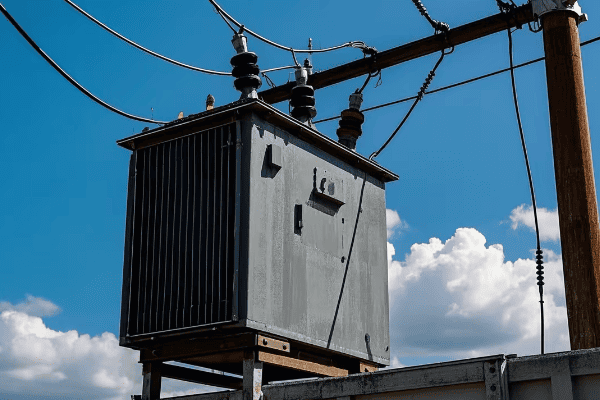
Let’s break down the factors that contribute to the cost-effectiveness of pad mount transformers:
1. Lower Maintenance Costs
Pad mount transformers typically require less maintenance:
- Easier Access: Ground-level installation reduces labor time and equipment needs for routine checks.
- Protected Components: Enclosed design means less wear from environmental factors.
- Fewer Emergency Repairs: Better weather resistance leads to fewer failure-related maintenance calls.
2. Longer Lifespan
The design of pad mount transformers often results in a longer operational life:
- Better Protection: Shielding from elements extends component life.
- Easier Upgrades: Modular designs allow for component upgrades without full replacement.
- Reduced Stress: Less exposure to extreme temperatures and weather events.
3. Energy Efficiency
Many pad mount transformers are designed for improved energy efficiency:
- Advanced Materials: Use of low-loss core materials reduces ongoing energy waste.
- Optimized Cooling: Better cooling systems maintain efficiency over time.
- Smart Features: Compatibility with smart grid technologies for optimized load management.
4. Reduced Land Costs
In urban areas, pad mount transformers can lead to land cost savings:
- Smaller Footprint: Requires less dedicated land than pole-mounted systems.
- Multi-Use Spaces: Area around pad mount transformers can often serve other purposes.
- Underground Integration: Allows for more efficient use of valuable urban real estate.
5. Lower Insurance and Liability Costs
The safer design of pad mount transformers can lead to cost savings in unexpected areas:
- Reduced Accident Risk: Lower chance of public interaction means fewer liability issues.
- Better Safety Record: Can lead to lower insurance premiums for utility companies.
- Compliance with Regulations: Easier to meet evolving safety standards, avoiding potential fines.
Here’s a comparison of long-term cost factors between pad mount and pole mount transformers:
| Cost Factor | Pad Mount | Pole Mount |
|---|---|---|
| Initial Installation Cost | Higher | Lower |
| Annual Maintenance Cost | Lower | Higher |
| Expected Lifespan | 30-40 years | 20-30 years |
| Energy Efficiency | Generally Higher | Variable |
| Land Use Cost | Lower in urban areas | Higher in urban areas |
| Replacement Frequency | Less frequent | More frequent |
| Emergency Repair Costs | Lower | Higher |
| Insurance/Liability Costs | Potentially Lower | Potentially Higher |
I remember a project for a large urban development where we initially balked at the higher upfront costs of pad mount transformers. However, after conducting a 20-year total cost of ownership analysis, we found that the pad mount option would save nearly 30% in overall costs compared to pole-mounted units. This was due to lower maintenance needs, reduced energy losses, and the ability to use the land around the transformers for other purposes.
The cost-effectiveness of pad mount transformers extends beyond direct financial savings:
- Improved Reliability: Fewer outages mean less lost revenue for businesses and fewer inconveniences for residents.
- Aesthetic Value: In residential and commercial areas, the improved aesthetics can contribute to higher property values.
- Futureproofing: Easier integration with smart grid technologies can reduce future upgrade costs.
For utility companies and city planners, the long-term savings of pad mount transformers translate to:
- Better Budget Allocation: More predictable maintenance costs allow for better long-term financial planning.
- Improved Customer Satisfaction: Reliable service and lower long-term costs can be passed on to consumers.
- Sustainable Investment: Aligns with long-term sustainability goals, potentially attracting environmentally conscious investors.
In the broader context of infrastructure development, the cost-effectiveness of pad mount transformers contributes to:
- More Efficient Urban Planning: Allows for better use of limited urban space.
- Reduced Environmental Costs: Lower energy losses and longer lifespan mean reduced environmental impact over time.
- Innovation Incentives: The success of pad mount transformers encourages further investment in efficient electrical technologies.
In conclusion, while the initial investment in pad mount transformers may be higher, their long-term cost-effectiveness makes them a smart choice for modern electrical infrastructure. By considering the total cost of ownership, including maintenance, energy efficiency, and lifespan, it becomes clear that pad mount transformers offer significant financial benefits over their operational life.
Conclusion
Pad mount transformers offer numerous advantages in modern electrical systems, including enhanced safety, space efficiency, aesthetic appeal, improved reliability, easy maintenance, environmental protection, and long-term cost-effectiveness. These benefits make them an ideal choice for urban and suburban power distribution needs, balancing functionality with community and environmental considerations.
Free CHBEB Transformer Catalog Download
Get the full range of CHBEB transformers in one catalog.
Includes oil-immersed, dry-type, pad-mounted, and custom solutions.
Quick Message
Request A free quote
We'd like to work with you
- +86 15558785111
- [email protected]
- +86 15558785111
What We Do
CHINA BEI ER BIAN (CHBEB) GROUP, with 218 million in registered capital, originated from Beijing Beierbian Transformer Group. Headquartered in Beijing for R&D, it operates major production bases in Nanjing and Yueqing, producing high-quality products.
Latest Product
address
BeiJing
No 3,RongJing East Road,BeiJing Economic Technological Development Area,BeiJing,China
JiangSu
No 7️Xiangfeng Road,Jiangning,NanJing,JiangSu,China
WenZhou
No.211, Wei 16 Road, Industrial Zone, Yueqing, Wenzhou, Zhejiang, China.
XiangYang Industrial Zone ,YueQing,WenZhou,ZheJiang,China
contact us
- [email protected]
- +86 13057780111
- +86 13057780111
- +86 15558785111
Copyright © Bei Er Bian Group


